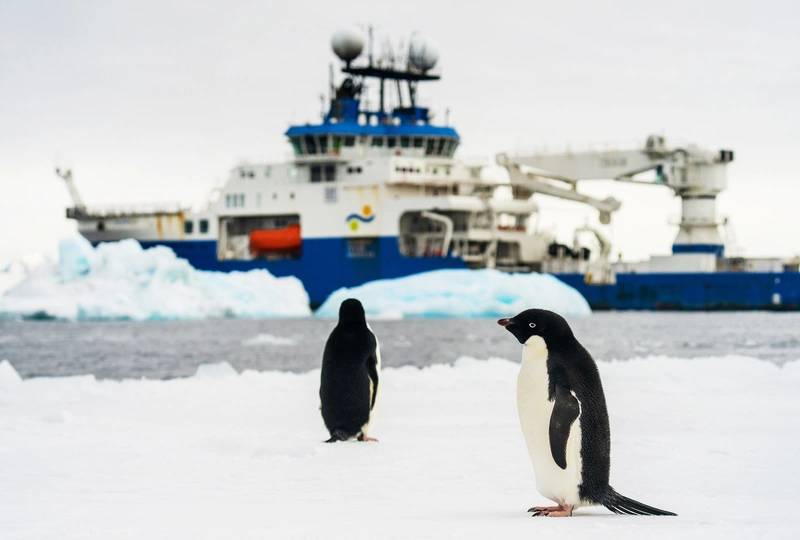After a year of preparing the ship and crew, Schmidt Ocean Institute’s research vessel Falkor (too) has completed its first science expedition to Antarctica. The three-week expedition, which ended in early January, was ambitious in its science scope and required operational refinements to navigate safely in unfamiliar environmental conditions.
“Operating our ship in the Southern Ocean marks a significant milestone in Schmidt Ocean Institute’s history,” said Eric King, senior director of maritime infrastructure. “R/V Falkor (too) performed exceptionally well, our crew gained a tremendous knowledge and experience, and the expedition prepared us well for future explorations around this part of the global Ocean in the coming decade.”
R/V Falkor (too) is a certified Class C polar vessel, which means it can operate in austral summer when there is light sea ice, also known as first-year ice. The ship received its polar certification from the International Maritime Organization (IMO) in October 2024. It was operationally supported by EYOS (Expeditions, Yachts, Operations, and Support Services), an internationally known polar expedition organization. EYOS aided in mission planning, permitting, and more. King said two ice pilots also joined the expedition to ensure the vessel safely maneuvered around icebergs.
The scientific operations included eight dives to depths as great as 3,918 meters (nearly 2.5 miles) using the remotely operated vehicle (ROV) SuBastian to assess biodiversity and explore vents and seafloor mapping. Ice pilots and crew transported scientists via small boats to places like Joinville Island, off the northeastern tip of the Antarctic Peninsula, for research on marine mammals and sea birds.
The ship’s satellite systems also live-streamed ROV dives, connecting the global population with the Antarctic seafloor. The rare sights included icefish guarding their eggs, cold Antarctic seep environments characterized by bacteria feeding on chemical energy, and dense sponge and kelp outcrops in frigid minus 1 degree Celsius water (about 30 degrees Fahrenheit).
“For many seafarers and explorers, rounding Cape Horn, crossing the Drake Passage, and sailing to Antarctica are bucket list items,” said Schmidt Ocean Institute Captain Peter Reynolds. “It was a collaborative effort by the entire team and such an amazing experience to have safely navigated our way to the seventh continent in the name of advancing science.”
The understudied Southern Ocean occupies a quarter of the global ocean surface. It plays an outsized role in regulating the Earth’s climate systems, absorbing an estimated 40% of anthropogenic carbon emissions and nearly 75% of excess heat in the atmosphere yearly.
The inaugural expedition to Antarctica called “Into the Southern Ocean” was a collaboration between the Schmidt Ocean Institute and the National Geographic Society. As part of the Society’s Perpetual Planet Ocean Expeditions supported by Rolex’s Perpetual Planet Initiative, a multidisciplinary cohort of National Geographic Explorers conducted a comprehensive scientific examination – from sea ice to the seafloor – of this critically important yet understudied marine ecosystem to advance conservation solutions in the Southern Ocean.
Also on board was Schmidt Ocean Institute’s Artist-at-Sea, Julian Charrèire, a French-Swiss artist based in Berlin. His work encompasses film, photography, and sculpture as a means to explore ideas of nature and its transformation over deep geological and human historical time. Charrèire was recently awarded the Eric and Wendy Schmidt Environment and Art Prize from the Museum of Contemporary Art (MOCA) in Los Angeles, California.
After one more Antarctica expedition in early 2025, R/V Falkor (too) will spend the next four years primarily supporting research in the South Atlantic Ocean.
“This was just the beginning of our journey into polar environments. I am proud of our incredible crew and staff for our first successful voyage into the Southern Ocean,” said Schmidt Ocean Institute Executive Director Dr. Jyotika Virmani. “Our plan is to visit Antarctica multiple times over the next decade, supporting vital scientific research in parts of the Ocean which may seem remote but are intricately connected to the wellbeing of everyone on this planet.”

